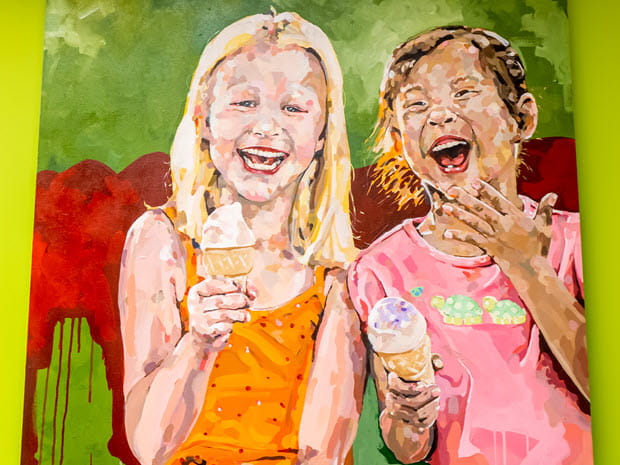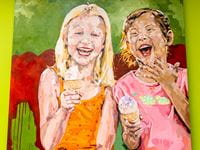Community Impact
Portland artist sees career flourish after work appears at Randall
January 31, 2024
Home > About > News & Media > Story Center
Like many artists, Jeremy Okai Davis spent periods of his childhood doodling. The drawings were just a way to pass the time. Basketball was going to be his future. But after spending a year playing basketball at a junior college, he returned home to Charlotte determined to pursue art as a career.
When he enrolled at the University of North Caroline at Charlotte, he assumed his studies would focus on graphic design. But then he met some students in the school’s painting department. He found his calling. Fast forward to 2007 when Jeremy moved to Portland and became serious about his art.
“I finally felt comfortable calling myself a professional artist,” he said.
His career took off in 2012 when Legacy commissioned Jeremy to create paintings for Randall Children’s Hospital at Legacy Emanuel. Today, we honor Jeremy and other Black artists as we celebrate Black History Month’s theme of art as a platform for social justice.
In this Q&A, Jeremy talks about his early years as a professional painter, where he draws inspiration and how art empowers him.
When he enrolled at the University of North Caroline at Charlotte, he assumed his studies would focus on graphic design. But then he met some students in the school’s painting department. He found his calling. Fast forward to 2007 when Jeremy moved to Portland and became serious about his art.
“I finally felt comfortable calling myself a professional artist,” he said.
His career took off in 2012 when Legacy commissioned Jeremy to create paintings for Randall Children’s Hospital at Legacy Emanuel. Today, we honor Jeremy and other Black artists as we celebrate Black History Month’s theme of art as a platform for social justice.
In this Q&A, Jeremy talks about his early years as a professional painter, where he draws inspiration and how art empowers him.

How has art impacted your life?
When I was young, I was finding different ways to express myself. Art was always there; it was a constant. I learned as I got older that art also gave me a voice. I’ve gotten more recognition for that voice as my career has progressed. I’ve also learned that as my voice has gotten louder, it’s given voice to others and allowed them to raise their voices.
How does art empower you?
It’s that voice that I know art can be. I heard that from artists I’ve impacted. That lets me know that anything is possible and gives me permission to magnify what I’m trying to say.
How have you grown as an artist?
Initially, my work was insular. It was just about me and my friends. It didn’t have an opinion. It didn’t have enough teeth to it, to grab people. I just worked for myself, which isn’t a bad thing.
I’ve kept that part of my work, but I also started listening to other people and concerning myself with the world at large and inserting that into my work. That’s the biggest growth for me. I think about other people, I take in opinions and thoughts I’ve heard and read when I do research. That makes the work more weighted.
|
Featured in the slideshow above is Jeremy Okai Davis' artwork at Randall Children's Hospital |
|
How did you get involved with the art project at Randall Children’s Hospital?
I was teaching the daughter of a board member on Randall’s foundation and the mom told me about the opportunity. I applied and was given the chance to paint. My idea was to create paintings the expressed joy.
I chose bright colors and painted kids having fun. A lot of the time hospital visits are stressful. I wanted to give people a reprieve or something to bring you joy even for a moment. I’ve had friends who have visited the hospital and they reached out to me to let me know they saw my paintings. It made their visit better. It’s worked.
How did that project impact your career?
That project was a catapult. Before then I was grinding at getting my work into galleries. I had tunnel vision on where art can be. Doing that project opened my eyes to other public venues where the work could be. I realized that public spaces also make the work more accessible and available to people who would not normally go into a gallery.
How has your form of art helped or had a positive impact on the community?
Some of the most recent work I’ve done highlights African Americans in history that maybe didn’t get the acclaim they deserved at the time. I’m backtracking, going into history and looking up people, unsung African Americans. This work empowers the community and lets them know we’ve been here and done important things. It’s not a new thing. I want people to feel comfortable being themselves. I think a lot about kids in the work and empowering them. Every so often I’ll meet someone who has seen the work and I hear how it impacted them and opened up people’s minds.
Why do you think it’s essential that we have more Black artist represented?
It’s course correction in a way. It’s past due and making up for lost time. Seeing work by Black artists in public places as much as possible allows young people of color to see themselves represented and in turn empowers them to follow their dreams. The more people see people who like them on walls, makes them confident to do what they want to do. It also showcases Black excellence.
What Black artist do you look up to and why?
- Kerry James Marshall. He’s a beacon for me and some who I look to when I’m stuck for ideas.
- Noah Davis inspires me by how he blended abstraction, loose representation and figuration. His passing right at the beginning of his prime pushes me to go forward because life can be short.
- Lynette Yiadom-Boakye. I get stuck belaboring the work. She paints fast, doing a painting a day. I look to her for the impulsivity and being okay with looseness in my work.








